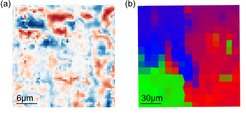Optical Investigation of Quantum Materials
Our group is working on directly visualizing broken symmetry phases in quantum materials: their temperature dependence, spatial structure, dynamics, and the way they are influenced by external stimuli such as magnetic field, electrical current or uniaxial strain.
All observable properties of materials are governed by the underlying symmetries, and the energy scales associated with those symmetries. However, few experimental probes are directly sensitive to the presence of different symmetries, or their breaking. Reflectivity is an example of a quantity which is. Controlling the properties of incoming light and measuring the properties of the reflected light allows us to study the breaking of rotation, time-reversal or inversion symmetry with exquisite sensitivity.
Furthermore, topological defects, separating different realisations of broken symmetry, are naturally formed at symmetry breaking phase transitions. While bulk probes are necessarily sensitive both to homogeneous regions and to the topological defects, the spatial resolution of our techniques allows us to choose which of the two we wish to study – both may be of fundamental interest.
Finally, the true power of the spatially resolved optical probes described above becomes apparent when they are combined with external tuning parameters, such as magnetic field or strain, which can drive phase transitions in quantum materials. This allows for direct visualisation of the way external tuning yields the broken symmetry phase, and gives access to studying the spatially-resolved dynamics of this process.

